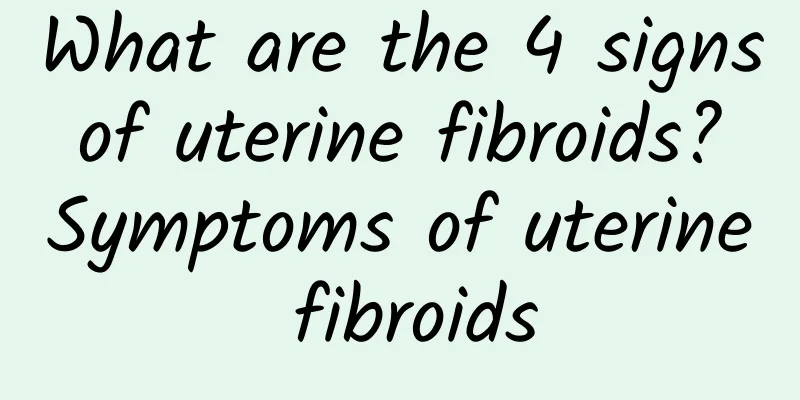What are the 4 signs of uterine fibroids? Symptoms of uterine fibroids

|
What are the 4 signs of uterine fibroids? Symptoms of uterine fibroids Uterine fibroids are a common tumor disease in women, mainly occurring in women of childbearing age. They are tumorous lesions formed by abnormal proliferation of uterine muscle cells. Although uterine fibroids do not necessarily cause symptoms, in some cases there are some obvious signs. This article will introduce the 4 signs of uterine fibroids and their symptoms. The first sign is abnormal menstruation. Uterine fibroids often lead to irregular menstruation, including symptoms such as prolonged menstruation, increased menstrual flow, and blood clots during menstruation. Some patients also experience increased menstrual pain. This is because the presence of uterine fibroids affects the normal shedding and recovery of the endometrium, leading to abnormal menstruation. The second sign is pelvic pain. Many patients experience pain in the lower abdomen or pelvic cavity when uterine fibroids occur. This pain can be continuous, dull, or paroxysmal. Some patients also experience back pain, perineum discomfort, and pelvic oppression. The third sign is frequent or urgent urination. Uterine fibroids are located in the appendages of the uterus, which are adjacent to the urinary system. When uterine fibroids grow and compress the urethra or bladder, patients may experience symptoms such as frequent urination, urgent urination, and weak urination. This is because the pressure of uterine fibroids affects the normal function of the urinary system. The fourth sign is compression of abdominal organs. If uterine fibroids grow to a certain size, they may cause compression of abdominal organs. This can cause patients to experience symptoms such as abdominal distension, indigestion, difficulty in defecation, abdominal pain, etc. Some patients may also feel a mass in the abdomen. Although uterine fibroids are common, many patients still do not know enough about them. Knowing the four signs of uterine fibroids can help patients detect them in time and seek medical treatment. However, these signs are not necessarily pathological signs of uterine fibroids and may also be related to other diseases. Therefore, if the above symptoms occur, it is recommended that women seek medical attention in time and undergo relevant examinations to clarify the cause. Knowing the 4 signs of uterine fibroids can help prevent and identify the disease. If women experience symptoms such as abnormal menstruation, pelvic pain, frequent and urgent urination, and compression of abdominal organs, they should seek medical attention in time. Early detection and treatment can help patients better manage uterine fibroids and avoid further complications. |
>>: Why do I only see uterine fibroids on one side? Why do uterine fibroids grow on the left side?
Recommend
What are the early symptoms of cervical erosion?
Cervical erosion should be treated as soon as pos...
What should I eat after an abortion to recover quickly? What medicine should I take after an abortion?
What to eat after abortion to recover quickly Whe...
What medicine can cure functional uterine bleeding faster?
Functional uterine bleeding can be relieved by dr...
Lose weight and don’t gain it back! Study: 2 cups of coffee a day is super effective
Losing weight is not easy, and keeping it off aft...
Surgical cure rate of cervical precancerous lesions
Clinical follow-up observations show that it take...
Four behaviors of men may increase the probability of their wives developing cervical cancer. Women should know how to say "no"
As a gynecologist, I have encountered many distre...
Will the pregnancy test stick show one dark spot and one light spot a few days before menstruation?
Will the pregnancy test stick show one dark spot ...
Hyperprolactinemia drugs
Treatment for high prolactin. Prolactin is a poly...
What are the main symptoms of cervicitis?
Among the many diseases of the cervix, cervicitis...
How to prevent dysmenorrhea in winter?
The weather is colder in winter, and the number o...
Pelvic inflammatory disease is one of the factors causing irregular menstruation
The triggering factors of irregular menstruation ...
How long after a miscarriage can you have sex? Doctors tell you 3 things to pay attention to after a miscarriage
The time of sexual intercourse after abortion mus...
When is the ovulation period after abortion? What are the symptoms of the first ovulation after abortion?
When is the ovulation period after abortion? Symp...
High stress can cause insomnia, constipation and five other major diseases! Regulating endocrine disorders and fighting obesity
Office workers are under great pressure at work, ...
What are the common types of menopause?
Understanding the types of menopause is to help e...









